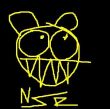| btimm |
|
25 Jan 2010 15:42 | Quote |
Joined: 14 Dec 2009 United States  Lessons: 2 Licks: 1 Karma: 16 
|
Okay, I apologize ahead of time if this seems silly. I was looking up the fingerings for some barre chords and I noticed that if you maintain the pattern, but move it on the neck, you create a chord with a different root note. For example, a G chord and an F chord would be:
e:--3-- e:--5--
B:--3-- B:--5--
G:---4- G:---6-
D:----5 D:----7
A:----5 A:----7
E:--3-- E:--5--
Similarly, this would work with a different fingering pattern like this:
e:--10----- e:--12-----
B:-----12-- B:-----14--
G:-----12-- G:-----14--
D:-----12-- D:-----14--
A:--10----- A:--12-----
E:x E:x
So it seems that it is much easier to switch from various chords to other various chords using barre chords as opposed to open chords. I see the reason for using open chords instead of power chords, because I have learned that power chords aren't in fact chords, since they contain no 3rd. But why would you play an open G for example instead of a barre G? Is there a theoretical reason or am I looking waaaaaay too deep into this? I often ask a lot of questions when learning about things. :-) |
| nater2 |
|
25 Jan 2010 15:54 | Quote |
Joined: 28 May 2009 United States  Karma Karma: 4 
|
Well first off, that's G and an A chord ;) . But i think for a lot of people, open chords are easier and they don't require as much finger strength and usually stay in a smaller part of the neck. |
| btimm |
|
25 Jan 2010 15:56 | Quote |
Joined: 14 Dec 2009 United States  Lessons: 2 Licks: 1 Karma: 16 
|
Doh, I meant A! Oops. |
| gx1327 |
|
25 Jan 2010 15:58 | Quote |
Joined: 20 Sep 2009 United States  Karma Karma: 9 
|
first of all, congrats on finding out why barre chords are so easy. if you think about it, most open chords ARE barre chords, except there is no need to barre the 0 fret with your index finger. take a look at A major, A minor, E major, and E minor.
on top of that, you can also create chords similar to C major and G major. they are a little more difficult to pull off, but if you played the chord:
2
-3
2
--4
---5
x
it would also be a chord (the root note is whatever the 5th fret of the A string is... D major)
as to WHY you would play them differently... well, although it's the same chord, they don't have the exact same sound to them. for instance, there are two ways to play open G major:
---3
0
0
0
--2
---3
and
---3
---3
0
0
--2
---3
both of them are technically G Major, and both of them are "open" chords, but the later seems a little "brighter" because of the higher note on the 5th string.
PERSONALLY i find that when playing a song with open chords, it's easier to stick to open chords... as oppposed to switching between open and barre chords. take the yeah yeah yeahs' "turn into"
C, Am, Em, G
it is easier to play these all open instead of playing C, Am, Em open and then G with a barre.
FINALLY, if you want to go note-for-note, the 5-string-barre-chord contains all of the exact same notes as its 6-string-barre-chord, except the 6 string contains a higher-octave note in it.
i.e. if you played E Major:
7
---9
---9
---9
7
x
or
12
12
--13
----14
----14
12
the later (6 string) would have a higher note in it than the former (5 string). it would be the same as playing
x
12
--13
----14
----14
12
hope that makes sense... |
| gx1327 |
|
25 Jan 2010 16:01 | Quote |
Joined: 20 Sep 2009 United States  Karma Karma: 9 
|
oh, and another example, also by the yeah yeah yeahs, is "gold lion" which according to tabs on the internet is played:
F#, A, E, A
however, it's played
F# (6-string barred at the 2nd fret)
A (6-string barred at the 5th fret)
E (open)
A (open)
try it and compare. same chords, yes, but iwth slightly different sounds to them. |
| btimm |
|
27 Jan 2010 11:40 | Quote |
Joined: 14 Dec 2009 United States  Lessons: 2 Licks: 1 Karma: 16 
|
Yeah, that si some good stuff, thanks a bunch! |
|
|



